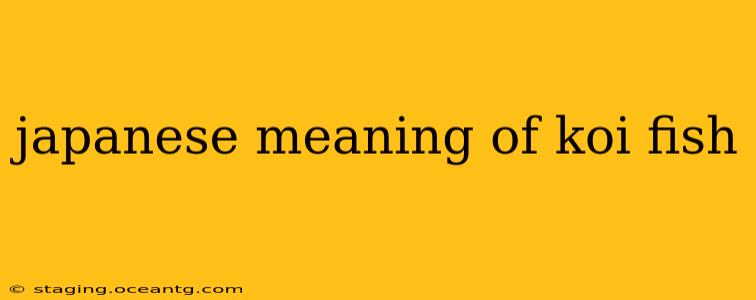Koi fish, with their vibrant colors and graceful movements, are much more than just ornamental pond dwellers in Japanese culture. They hold deep symbolic meaning, representing perseverance, strength, and good fortune. Understanding the Japanese meaning of koi goes beyond simple aesthetics; it delves into a rich history and tapestry of cultural significance.
What does Koi symbolize in Japanese culture?
In Japan, koi are powerfully symbolic creatures, often associated with good luck, prosperity, and perseverance. Their meaning is deeply rooted in the legend of the carp leaping upstream to become a dragon, a testament to their resilience and determination. This legendary ascent is frequently depicted in art and is a significant element of their symbolic weight. Different colors of koi even carry specific meanings, adding further layers of interpretation.
What are the different meanings of Koi colors?
Red Koi: Often associated with love and relationships, red koi also symbolize success and passion. Their vibrant color commands attention, mirroring the strength and energy they represent.
Black Koi (also known as Magoi): Black koi represent overcoming obstacles and difficulties. They symbolize strength, perseverance, and the ability to conquer challenges. Their dark color might seem ominous, but it actually symbolizes the strength needed to overcome adversity.
White Koi: Purity, innocence, and spiritual growth are often connected to white koi. They are seen as a symbol of new beginnings and a clean slate.
Blue Koi: Blue koi symbolize tranquility, peace, and harmony. Their calming presence reflects a sense of serenity and balance.
Yellow Koi: Yellow koi are associated with wealth, prosperity, and good fortune. They symbolize success and abundance.
Orange Koi: This vibrant hue represents ambition and creativity. Orange koi often symbolize a drive for success and the energy needed to achieve goals.
What are some common misconceptions about the meaning of Koi fish?
While the symbolism of koi is generally positive and auspicious, some misconceptions exist. It's important to understand that the meaning isn't necessarily fixed; the context and specific coloration can influence interpretation. For instance, while generally positive, the number of koi and their arrangement in a pond or artwork can also hold specific meanings.
Are Koi fish considered sacred in Japan?
While not considered "sacred" in the same vein as certain deities or religious objects, koi hold a significant place in Japanese culture and are deeply revered for their symbolic importance. Their image is used extensively in art, literature, and even in everyday life, reflecting the cultural esteem they possess.
How are Koi fish depicted in Japanese art?
Koi are frequently featured in Japanese art forms, especially in paintings and woodblock prints (Ukiyo-e). They're often depicted swimming upstream, symbolizing their perseverance. These depictions often feature dramatic landscapes, highlighting the koi's struggle against the current and their eventual triumph.
What is the legend of the carp leaping over the Dragon Gate?
The legend of the carp leaping over the Dragon Gate (Ryūmon) is central to the symbolism of koi. The story tells of carp swimming upstream against a powerful current, eventually reaching a mythical gate. Those carp that successfully leap over the gate transform into dragons, symbolizing the achievement of great success and transformation through perseverance. This legend emphasizes the powerful message of overcoming adversity.
Understanding the Japanese meaning of koi fish reveals a deeper appreciation for their significance within Japanese culture. Beyond their beauty, they represent enduring values and aspirations, making them a powerful and enduring symbol.
